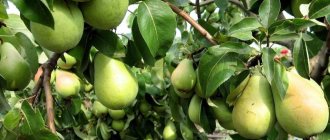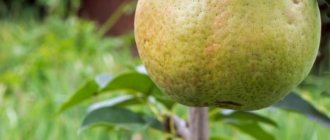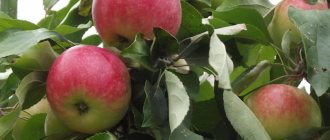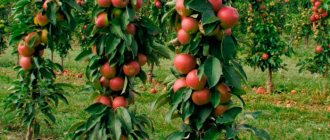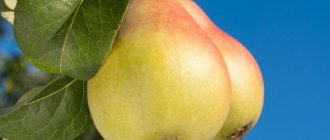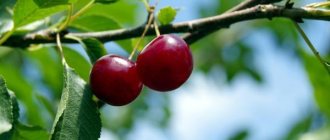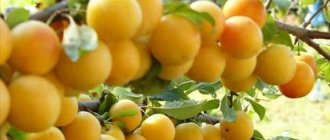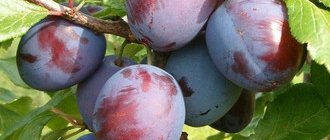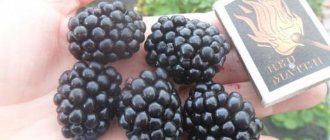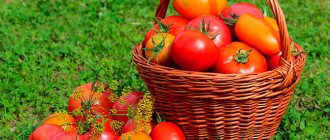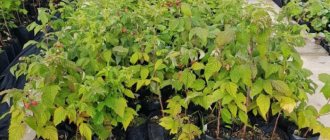Variety selection criteria
The weather in the Moscow region can be described in one word - unstable. Winter here is long, with frosts followed by sharp thaws. Sudden frosts may occur in spring. Therefore, it is worth taking a responsible approach to choosing a successful variety of self-pollinating apricot for Moscow and the Moscow region.
So, an apricot seedling must have winter hardiness. The main signs of frost tolerance include:
- the plant can withstand increasing air temperature drops down to -30 degrees;
- kidneys have little sensitivity to cold;
- how soon after warming the growth of a seedling and the appearance of ovaries on it awakens;
- During frost, the buds remain unharmed.
Since the Moscow region is vast, planting apricots is most successful in the south or southwest. Gentle southern and southwestern slopes near Moscow are also suitable. The area for planting seedlings should be illuminated by the sun. Equally important is protection from north winds and high humidity.
It’s worth knowing: successful varieties of apricot seedlings for the Moscow region are those that have increased resistance to sudden cold snaps and sudden changes in weather.
If we talk about the land where pears, plums, ash and maple trees grow, then the environment here is favorable for apricot seedlings. A tree that has reached a height of 1.2 meters must be grafted to protect the bark from becoming warm.
Another indicator of a successful variety for Moscow is self-fertility. An important selection criterion is if the tree can be pollinated by its own pollen or by seedlings planted nearby that belong to the same variety. Varietal trees are obtained in the only way - by grafting. This fruit cannot reproduce by cuttings.
Caring for young apricots in summer
Caring for a seedling in the first season does not involve performing specific work. They boil down to the following actions:
- the soil in the tree trunk circle is periodically loosened without injuring the roots;
- remove weeds growing through the mulch;
- treated against harmful insects and pathogenic microorganisms, because Apricot immunity is still weak;
- irrigate during dry periods;
- You should not overfeed the tree - if there is sufficient supply of nutrients, it is not advisable to additionally fertilize the apricot in the first year.
The gardener’s task in the summer is to provide conditions for the growth of seedlings. Timely watering and plant protection allow you to obtain significant tree growth in the first year.
The best apricot varieties for the Moscow region
Regarding the Central European region of the Russian Federation, the following names stood out the most:
- Black velvet;
- Alyosha;
- Iceberg;
- Winter-hardy Suslova;
- Snowfinch;
- Honey;
- Russian;
- Red-cheeked;
- Triumph Northern.
The above varieties of apricots are rated with the highest scores. In addition to these varieties, several more early-fruiting hybrids can safely take root in the Moscow region. Those who have been growing apricot trees for a long time advise beginners to plant the Lel variety, which turned out to be ideal and almost win-win for the Moscow climate.
Care
plant care
In order for the seedling to take root and develop well, it is not left unattended from the first days after planting. This period requires regular watering.
Do not allow the trunk to dry out. Spring planting stops watering in early August. This makes it possible to prepare the tree for winter conditions.
Tree care requires a clean stem circle. Grass plants are constantly removed and the soil is loosened. Fertilizer is applied from the second year of the tree’s life. Fertilization is carried out according to the following scheme:
- Early spring, nitrogen fertilizer;
- in summer, phosphorus fertilizers;
- in autumn, fertilizers are overflowing.
Preventive measures will be taken in the fall. Fallen leaves and plant debris are collected. Everything must be burned. This event prevents the development of fungal diseases.
One of the most important activities is tree pruning. This is a complex and time-consuming process. However, this is a very important point that affects the formation of the tree, its health and productivity.
It is necessary to form the top of the tree. It should not be thickened. During spring pruning, frozen shoots are removed. All cuts are covered with garden bubble.
Do not cut the lower branches of young trees. They can be cut back after the plant begins to bear fruit. This pruning promotes intensive tree growth and increased yield.
Apricots are lightened between October and December. It is a sunscreen in winter and spring and protection against freezing.
For landscaping, you can use a ready-made mixture. Add 20 g copper sulfate. You can also make the decision yourself. You can add it to a composition:
- ground lime;
- Cowgirl;
- Sound;
- Copper sulfate.
It is important to know that in gardens in the Moscow region it is not recommended to insulate trees for the winter with all types of coatings. If there is a danger of damage to trees by rodents, the tree trunk should be protected with spruce bone.
It is necessary to notify not only the tree trunk, but also the skeletal branches. In addition to its protective functions, it is an excellent prevention of fungal diseases.
crown formation
When caring for apricots, you should not forget about protection from diseases and pests. All fruit trees are susceptible to disease. Apricots are no exception.
Dangerous diseases include many fungal, viral and bacterial diseases that can infect trees. Apricots are susceptible to diseases such as virus diseases, dehydration and wilt. Diseases caused by fungi:
- Vertical;
- Fusarium;
- Cytosporosis;
- Moniliosis;
- Clusterosporiasis and other diseases.
Apricot tree is white, whitewashed.
Clusterosporiosity is most often characteristic of the climate of the Moscow region. These diseases are caused by constant companions in every garden plot.
Prevention of diseases and pests can be achieved through regular and timely agrotechnical measures. Chemicals are also used to spray trees.
This activity requires strict adherence to the instructions for use of the drug. The time of occurrence of the event occurs in the spring period preceding the release of buds.
It is important to remember that in the fall it is necessary to remove plant debris. They are burned. If you follow all the gardening rules, you may not have to use chemicals in your garden.
Cultivation of apricots in the Moscow region requires the correct selection of zonal varieties and all agrotechnical techniques. The combination of these factors will allow us to obtain high yields of magnificent apricot fruits in the Moscow region.
We present to your attention a video about apricots that can be grown in the Moscow region:
Page 2
Many fruit and berry crops undergo cross-pollination. To produce fruit, they need pollen from other plant species, which is carried by pollinating insects such as bumblebees, bees, beetles and even butterflies.
When plants self-pollinate in their natural habitat, their offspring often emerge weak and sterile. This explains the fact that pollination occurs extremely rarely in the plant world.
Self-fertile varieties
Such apricots can be an ideal option for decorative garden lands, where you can plant several trees to decorate the area. They bear fruit every year because they can pollinate themselves. The following are the most popular varieties with good self-fertility for the Moscow region.
Red-cheeked
3-4 years after the tree was planted, you can reap a high-quality harvest. Fruiting of the Red-cheeked variety begins in mid-summer. Its yield can pleasantly surprise you - up to 100 kilograms of juicy apricots are produced from one tree. The ripe fruits reach up to 50 grams. They have an oval shape, orange color with reddish splashes.
Thanks to its thick skin with velvet fluff, this fruit tolerates transportation well. Ripe fruits can be easily pitted. The bone in an apricot is small - it occupies about 7% of the total mass. The taste of Red-cheeked is sweetish, with a sufficient amount of sucrose, juicy, the sourness is almost imperceptible. The only drawback is that this tree may not survive strong humidity, so it is recommended to graft it.
Pineapple
From such a tree you can harvest up to 150 kilograms of fruits annually. Apricots ripen at the end of July. The fruits of the Pineapple variety reach up to 50 grams and have a round, lumpy, uneven shape. The bone inside is not large, it can be easily removed.
The fruit itself is bright yellow, and a reddish spot can often be seen on the side.
The pulp has a light yellow fibrous structure, with a high content of juice and sucrose. It is better to eat pineapple fresh, as when preserved it loses its taste. If there is a threat of frost, it is recommended to cover the tree with oilcloth or other insulating materials.
Melitopol early
The fruits reach peak ripeness towards the beginning of August. Its yield is estimated at 100 kilograms per tree annually. Can grow up to 6.5 meters, often requires pruning of branches. The weight of one apricot is about 40 grams. The fruits are oval in appearance, yellow-orange in color, with subcutaneous black dots.
The taste is sweetish, slightly tart, the flesh is juicy, bright orange. The apricot skin is soft, with fluff. Apricots are used in the preparation of jams, confitures, and compotes. They are not recommended for transportation due to their soft skin.
See also
Characteristics of the Manchurian apricot variety, description of frost resistance and seedling careRead
Lel
Compact trees of this variety do not reach a height of more than three meters. They grow slowly and are moderately branched. The active rays of the sun can make them grow faster. The fruits from such a tree have a flattened-round shape, their weight reaches no more than 23 grams. Apricot skin is most often glossy. The pulp is juicy, elastic, bright orange.
Lel tolerates transportation well. The variety is known among gardeners for the fact that its fruits are characterized by a balanced taste. Such trees are resistant to sudden frosts. The disadvantages include the large bone, so it is better to remove it to make jams or confitures.
Diseases and pests
A good, warm, sunny summer with moderately windy weather reduces the incidence of disease by almost 100 percent. But cold, cloudy and little windy weather is fraught with the occurrence of moniliosis (rotting of fruits, drying out of shoots and flowers) and klyasterosporiosis (rusty spots on the foliage with the impending formation of holes).
Preventive measures consist of good plant care; accordingly, weakened apricots have a much higher risk of disease. Therefore, fungicidal treatments should be carried out regularly, with particular preference given to copper-containing products.
The preparations “Iskra” and “Decis” help against aphids and codling moths.
In addition, you must:
- carry out proper pruning every year, avoiding thickening of the tree;
- water, feed and loosen the soil in a timely manner;
- regularly collect dried, damaged fruits;
- dispose of diseased branches;
- Ensure good ventilation of the garden to avoid stagnation of damp air.
Columnar apricots
These varieties are prized because they are compact and also look beautiful in gardens or homesteads. The trees are beautiful and eye-catching, and they also bring a generous annual harvest. With proper care, seedlings of columnar varieties produce high-quality apricots 2 years after they were planted in the ground.
Prince March
A low tree, reaching about two meters in height. Blooms in mid-March-early April. The fruits reach their peak ripeness in mid-summer. The color of such apricots is bright orange, with a slight blush. The weight of one Prince is from 35 to 60 grams. The leaves on the tree always have sharp tips. This apricot survives winter frosts well down to -35 degrees. Thanks to the appetizing sweetish pulp of Prince Martha, it is best eaten fresh.
Important: this plant requires regular watering, frequent fertilizing, pruning and prevention from harmful insects.
Star
This representative will take root in almost any climate of the Russian Federation. The apricot tree tolerates sudden cold snaps well. The weight of the fruit sometimes reaches 100 grams. The color is most often bright yellow, with smooth skin. If the flowers are removed from the plant in the first year of its life, then in the second year the tree will produce a generous harvest.
Which seedling is considered high quality?
High-quality seedlings meet the following requirements:
- Plant age. The best option is 1-2 years, young plants experience less stress. At an older age, trees take root less well and suffer longer.
- Type of root system. Seedlings with a closed root system (planted in a container) take root easier, do not experience stress, and are not picky about planting time. However, their cost is significantly higher. Plants without soil are cheaper, but they are difficult to recover at the slightest drying of the roots.
- Type of seedling. The bark of the tree should be even, smooth, without growths, cones and signs of damage by diseases or pests. The buds on the plant should not be awakened; in extreme cases, swollen ones are acceptable - this will increase the chances of survival.
- Availability of vaccination. Self-rooted apricots have less winter hardiness than plants grafted onto plum trunks.
The season of planting a seedling is important. The highest percentage of survival rate is given by plants planted in the spring before the start of sap flow. In unpredictable autumn conditions (sharp cold snaps, snowfalls), the apricot may not have time to take root and will die in the winter.
Following the rules for choosing apricot seedlings (taking into account the characteristics) will allow you to get a plant that is accustomed to the local climate, which will bear fruit just a few years after planting.
Winter-hardy and frost-resistant varieties
Due to the unstable climate near Moscow, picky fruit trees can freeze. But if you choose certain varieties of apricots that can survive harsh winters and sudden thaws, you can get a fairly generous harvest.
Snegirek
In terms of winter hardiness, it outperforms other varieties. If it is covered with a light shelter in winter, then Snegirek can safely bear fruit in the northern regions. Such a low tree usually does not exceed 1.5 meters in height. Not afraid of sudden frosts. Grows in good and poor soils.
The fruits of this variety have a dense skin, and their quality can be maintained until the end of December. The color of the fruits is light yellowish, with a slight blush. The pulp is sweetish, pleasant in taste and smell, but sometimes tastes bitter near the skin. The disadvantage of Bullfinch is a tendency to monoliosis and spotting.
Triumph Northern
Such a delicious juicy apricot was obtained through the selection of two apricots. They were Red-cheeked and Northern Early. The fruits from such a tree have a round, slightly flattened shape. The apricot is covered with light fluff. It tastes sugary, soft and juicy. The color of the fruit is usually yellowish-orange, with a scarlet blush.
The harvest reaches peak maturity at the end of July. Can grow up to 4 meters. The weight of one apricot is 45-55 grams. The harvest from one tree is 60-70 kilograms.
Hardy
This apricot is named so for a reason. This is because it can take root even on the most unfavorable soil and survive frost, moisture and heat. In the spring, when sudden cold weather can kill the buds of other apricot varieties, Hardy will safely endure such weather inconveniences.
The tree can grow quickly, but it begins to bear fruit only after 5 years. The fruits at the peak of ripeness are medium in shape, up to 60 grams. The color of the skin is light orange, with fluff. The inside of the fruit is sweet, with a pleasant aroma. The harvest from one tree is up to 80 kilograms. It is recommended to collect fruits from Endurance closer to the beginning of August.
Step-by-step planting technology
First of all, it is necessary to properly prepare the seedling before planting, because this determines how well it will take root in the new place. You need to choose an apricot tree very carefully, choosing a specimen without visible damage to the bark and root system.
The rules for planting apricot seedlings are very simple; just follow these steps exactly:
First soak the roots in plain water, as they should be well saturated with moisture. It is better to carry out this procedure a day before the planned landing. Lubricate the root system generously with a special mixture that is easy to make yourself - combine manure, water and clay. Then leave the seedling for a while until the roots dry. Prepare the planting hole, be sure to add a layer of drainage to the bottom and pour in a little water. If you do not use drainage, there is a risk that the roots of the tree will begin to rot. Place the prepared seedling strictly in the center of the planting hole
Perform all actions carefully so as not to accidentally damage the root system. Cover the hole with soil and compact the soil a little.
It is better to take an assistant who will hold the tree so that it stands straight and does not tilt. Drive the support peg nearby, but not too close to the seedling, so as not to damage the roots. Tie the tree to the peg. After planting, be sure to water the seedling. Fertilize the soil around the apricot tree with humus or peat.
Strict adherence to each stage allows you to speed up the rooting process of the seedling and getting used to the new place of growth.
The gardener provided a video with step-by-step planting of an apricot seedling:
Low-growing apricot varieties
The convenience of dwarf trees for the garden is determined by their compactness, attractive appearance and convenience. The height of such apricots is no higher than three meters. Dwarf apricots can begin to bear fruit in the second or third year of life.
The only drawback of such trees is special attention to soil moisture.
Airlie Red Orange
One of the most successful very early hybrids. Brought out in America in 1920. In the Moscow region, fruit ripening occurs at the end of June and beginning of July. By weight, one apricot is approximately 65 grams. Early Red Orange tolerates transportation and can be stored for a long time in wooden boxes.
Mature trees look like small poplars. The branches grow compactly, extending from the crown at an acute angle. The pulp of the fruit is soft and light orange in color. According to the tasting assessment, the apricot received 4.7 points. The fruits are rich in vitamins and are recommended to be eaten fresh.
See also
Description of the early and late Melitopol apricot variety, selection history and yieldRead
Crimean Amur
The variety bred in the Nikitinsky Botanical Garden was well received by gardeners, and subsequently it took root in the Moscow region. The resistance of this tree is manifested to many fungal diseases, frosts and droughts. The tree grows with spreading branches and quickly gains height.
A mid-late variety. Self-fertile apricot, which guarantees a bountiful harvest for 5-6 years of life. The fruits are often round and weigh about 60-90 grams. The skin of the Crimean Amur is yellow-orange with a slight blush. The color of the pulp is light orange; the taste of the fruit is ripe and juicy.
The fruits of the Crimean Amur have good taste, therefore it is recommended to eat them fresh or make preparations with them for the winter. Apricots tolerate even long-term transportation well.
Ways to plant a tree
The soil and climatic features of the Moscow region require care taking into account some unfavorable factors that negatively affect the growth, development and fruiting of heat-loving garden crops:
- annual competent pruning, which will allow you to obtain fruit trees with small-sized and unthickened crowns;
- timely watering, high-quality fertilizing, regular weeding, loosening and mulching of the soil are very important;
- Damaged and dried fruits should be systematically collected, all diseased branches should be pruned and then burned;
- in winter, it is recommended to carry out moderate hilling with snow to a height of up to 50 cm, which will not allow the roots at the base of the trunk to become warm.
To get a strong tree, it is recommended to provide it with complete and high-quality care.
How often to water
Immediately after planting, the seedlings must be watered. In the first few years of a plant's life, it needs a lot of liquid. During the season, the seedling should be watered up to 6 times. An adult tree is moistened three times. If apricots are grown from seeds, watering should be more abundant. In spring, the soil should be moistened all the time
However, it is important to ensure that there is not too much water. This will cause the roots to rot
Feeding the tree
It is recommended to apply fertilizers from the second year of life. In this case, you should follow the following scheme:
- use nitrogen preparations in early spring;
- in summer the tree needs phosphorus;
- In the fall, rotted manure is used.
Apricots most often encounter the following problems:
- Monilial burn. High humidity leads to the development of the disease. At the same time, the fruits dry out and the leaves turn brown. Bordeaux mixture helps to cope with the problem.
- Cytosporosis. In this case, the bark becomes covered with mushrooms. It is recommended to immediately cut off damaged branches and burn them. At the initial stage, treatment with Bordeaux mixture is sufficient.
- Aphid. This insect is most active in the summer. Fungicides help cope with the problem.
Formative pruning
Pruning helps shape the crown, make the fruits larger and cope with diseases. The procedure stimulates growth processes, improves metabolism and strengthens the immune system.
Apricots should be pruned in early spring. In warm weather, the procedure can be carried out at the end of February.
It is important to complete the manipulations in the first half of April
In order for the tree to survive the winter normally, it is recommended to get rid of fallen leaves and dig up the soil. Young plants should definitely be wrapped for the winter. To do this, make a hut from sticks and wrap it in agrofibre. The bottom of the tree is covered with earth.
Adult plants can be wrapped in burlap. With the arrival of winter, it is recommended to sprinkle the tree trunk circles with snow. This will improve root storage and replenish fluid reserves.
Young apricot trees need more attention because they are less hardy than adults. But both babies and old people should always be well looked after, especially in May-June, so that they develop a powerful, healthy leaf canopy as early as possible.
The best way to protect flowers is to cover the crowns with two layers of agril or any fabric for the entire flowering period. Under such clothing, flowers are not afraid of frosts down to minus 4°C. In the corners, covering material is tied to the branches, but in such a way that pollinating insects can freely visit the trees.
In summer with good warm, sunny, moderately windy weather
, in any case, significantly less than our traditional stone fruits - cherries and plums.
The main condition for combating diseases and pests is good tree care. It is clear that weakened pets are more likely to get sick.
At the first signs of the disease, you should immediately spray the trees with copper oxychloride, topaz, topsin-M, strobe and other preparations. Be sure to add soap to the solution (50 g per 10 l). If necessary, spraying is repeated. Sometimes apricots are slightly damaged by aphids and codling moths, which are gotten rid of with the help of drugs such as spark, decis, inta-vir, again with the addition of soap.
— annual competent pruning so that the trees are small-sized and not dense;
— timely watering, fertilizing, loosening and mulching of the soil;
- collecting damaged and dried fruits, cutting out diseased branches and burning them;
- fences around the garden should be well ventilated so that cold, damp air does not stagnate;
- trees are covered with snow moderately (up to 60 cm), otherwise the bark of the base of the trunk may support it.
Early varieties
Such apricot seedlings are in great demand on the market. After all, first of all, early ripening is important for those people who sell apricots.
Aurora
It was bred by breeders in France. Fruits belonging to the Aurora variety can be harvested at the end of June. Ripe apricots are round in shape, with smooth dark orange skin and purple spots. Aurora has dense flesh, which makes it easy to transport.
They taste sweet and pleasant. Suitable for swirling jams, confitures and compotes. It is not difficult to care for the tree, but during severe cold weather it is recommended to insulate it with oilcloth.
Egyptian pharaoh
This variety is suitable for those gardeners who, after planting an apricot seedling, expect a quick harvest. Such a tree will begin to bear fruit in the second year. The fruits ripen quite early - in mid-June. Apricots are large - up to 100 grams. The skin on the fruit is bright orange. They taste pleasant, sugary, without sourness. The pulp has a lot of juice, practically without fibers or veins.
Egyptian pharaoh can be grown in the southeast of the Moscow region. It requires simple care - watering, feeding with fertilizers, trimming branches. Also, if frosts in winter exceed -25 degrees, it is better to cover the apricots with insulation.
Harostar
Refers to self-fertile varieties. It was bred in Canada. Harostar is loved in the CIS countries and is in demand on the Russian market. Ripens from the 20th of June to mid-July. Every year it brings a generous harvest - up to 100 kilograms from one tree. The fruits weigh up to 70 grams and are oval and flattened in shape.
The pulp is orange in color, the structure is not fibrous, without veins. Apricot tastes sweet and dessert. According to experts, it deserves 4.8 points out of 5. The fruits are not damaged during transportation. Resistant to shedding, disease and frost. The winter hardiness of the variety is high - the tree can easily survive -35 degrees.
Possible problems
The Moscow region is a difficult region for growing apricots, and the gardener faces some problems for which it is better to prepare in advance.
Apricot does not bear fruit
It happens that time passes after which the apricot should have already produced its first fruits, but this does not happen. There are several possible reasons.
Apricot does not bloom
If the apricot does not bloom, then perhaps the time has not come yet. Fruiting does not always begin within the time period specified in the description of the variety. There may be a delay for some reason, for example, the seedling turned out to be the wrong variety that was declared upon purchase. We need to wait another 1-2 years and, perhaps, everything will work out.
But more often in the Moscow region, such a situation can arise if, during periods of temperature changes, flower buds were damaged by frost. This happens sometimes and there is nothing you can do about it.
Apricot blooms, but does not form ovaries
This occurs when the apricot variety is not self-fertile and there is no suitable pollinator nearby. This is where the gardener makes a mistake. When planting, it was necessary to choose a self-fertile variety or simultaneously plant a suitable variety for pollination.
The second reason may be damage to flowers by a disease, for example, moniliosis.
Ovaries form but fall off
A possible cause is lack of nutrition and/or watering.
The apricot bears fruit, but the fruits do not have time to ripen
This is not uncommon for varieties with late ripening (for example, Favorite). In cold and rainy summers, the berries do not have time to ripen and remain immature on the branches. There's nothing you can do about it. We'll have to wait for the next season, perhaps it will be more successful.
The roots and trunk are warming up
The planting site was chosen incorrectly or there was a lot of snow in winter. It became denser, melting slowed down, and a too damp environment formed around the apricot trunk, conducive to damping off. The problem is easily solved by shoveling snow from the plant trunk in early spring and installing grooves to drain melting water.
Zoned varieties
Once upon a time, apricots could only be harvested in warm regions, but thanks to new developments in breeding, the best regionalized varieties have appeared. Such trees take root in the North and are also suitable for the weather in the Moscow region.
Elite hybrid I-05-6
Breeders crossed two self-pollinating varieties - Triumph Northern and Original, resulting in a hybrid that has taken root in the Russian market. The trees grow compact, low-growing, with a neat crown. The fruits usually ripen by the end of July. The weight of one apricot can range from 50 to 80 grams. Sweet fruits will delight even the most fastidious gardener with their quality.
Khabarovsk
Apricot self-fertile trees are considered winter-hardy. They bear fruit with a generous, high-quality harvest. The fruits are not suitable for transportation, so they are best grown for making homemade jams and compotes. Overripe fruits may have small black spots. At the ripe stage they have a yellow-green color, lumpy skin with fluff.
Alyosha
Ripens early - from mid-June. The tree can grow up to 4 meters. However, Alyosha can begin to bear fruit in 3-4 years if the tree has been grafted. In spring it blooms with beautiful flowers. Such a tree will decorate a garden or personal plot.
The fruits are round in shape and bright yellow with an orange spot on one side. The bone inside is large, but can be easily removed. Apricots are balanced in taste: they have a slight sourness and a sufficient amount of sucrose, their flesh is juicy.
If there is any difficulty regarding the question of which varieties are not damaged during transportation, Alyosha is one of the most successful in terms of transportation. They can survive sudden spring frosts as well as winter frosts. They should be consumed fresh or made into twists.
Choosing a location on the site
For planting, seedlings are taken, purchased or grown from seeds, the age of which varies from 1 to 2 years. They are planted by choosing the right place. It should not be lowland; the plant requires:
- a lot of warmth and sun;
- no drafts.
It is undesirable to use southern slopes, because in hot weather the growing season begins earlier, which harms the level of winter hardiness of the crop. Also in this case, flowering most often coincides with the last spring frosts.
It is also important to take into account the composition of the soil, which must be breathable. It is undesirable to allow water to flood or the soil to become waterlogged, as this can lead to the death of the plant.
You need to pay attention to the composition of the soil. If it is a clay composition, peat and sand are added to it in equal parts
Loams and light loamy soils with a slightly acidic or neutral reaction are ideal.
Methods for regulating growth and fruiting
Various gardening tricks will help to significantly improve the quality and quantity of fruits.
To improve yields and proper growth, the following applies to apricots:
- Changing the inclination of branches. The closer the skeletal branches are to the vertical direction, the more intense they will grow, and vice versa, the more horizontal they are, the less pronounced their growth will be. Tilting strong branches closer to a horizontal position promotes faster fruiting. You can change the slope by filing, spacers, and tying to lower branches, stakes, and trellises.
- Re-stretching the trunk and branches. It is made using wire lined with thin tin or boards; when a pronounced influx forms, it is removed. This manipulation stimulates the formation of flower buds.
- Furrowing of the bark. The procedure of longitudinal cuts of thin parts of sapwood and bark, carried out at the beginning of the growing season using a special garden knife. Manipulation allows you to obtain a significantly developed crown and thick trunks, which are significantly different from their “untouched by a knife” relatives. The most important thing is that productivity increases significantly.
Methods for regulating growth and fruiting
Self-fertile apricots: what is their fundamental difference from ordinary ones
Looking into history, you can find out that most varieties of apricots that appeared in the first half of the 20th century are mostly self-sterile (for example, Musa, Hekobarsh, Seraphim). The emergence of cultivars capable of yielding crops without additional pollination, or with partial pollination, is a scientific achievement of domestic and foreign breeders.
Self-fertility is the ability of trees to produce fruit without cross-pollination with trees of other varieties.
The apricot harvest depends on compliance with agricultural technology
Experts say that this varietal trait of stone fruits can be traced differently in different climatic conditions. And also the yield of a fruit tree, the number of ovaries of which does not depend on pollination, is largely influenced by:
- age of the tree;
- compliance with the rules of pruning fruit crops;
- prevailing weather conditions.
The self-fertility of apricots depends on the specific region. It can be checked simply by putting a bag on a branch before flowering and counting the number of flowers in this bag and the resulting fruits.
irisovi duh
https://dacha.wcb.ru/index.php?showtopic=66059&st=660
The fundamental difference between self-fertile apricots is that such trees are able to bear fruit without additional pollination. Their yield indicator will differ little from the average varietal indicators proposed by the authors of the cultivar. But the weather and compliance with agricultural practices no less influence the yield of the tree. Planting an apricot and forgetting about it until harvest is not possible. Without proper care, even a self-fertile variety will not produce abundant ovaries.
Most self-fertile apricots are precocious
Do not forget that the concept of self-fertility is relative. Absolute indicators (determined by varietal characteristics) of yield can be obtained with proper care, and they will not depend on pollination of the apricot. Indeed, self-fertilization will be productive in the absence of the possibility of cross-pollination. But the yield of the cultivar will be much higher if other apricots grow on the site and self-fertile varieties are additionally pollinated.
One of the first self-fertiles we had was Northern Triumph (planted in the spring). They chose it for the reason that they really wanted apricots, but the seedlings were a little expensive, and they dreamed of planting other trees. But it was not possible to check it for self-fertility - in the fall of the same year, Saratov ruby, another variety with an unknown name from friends from Rossosh, appeared on the site. The first fruits appeared simultaneously on all trees after 4 years. Perhaps the harvest would have been earlier, for example, on Triumph, but in past years there were return frosts in April, and we attribute the lack of ovaries in the 3rd year to this. This year (the 6th year of tree growth) there were a lot of apricots, but this was also an “apricot” year, despite the moniliosis that appeared in late spring.

